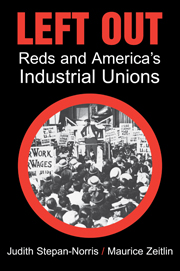Book contents
- Frontmatter
- Contents
- List of Figures and Tables
- Prefatory Note
- Acknowledgments
- Abbreviations
- 1 The Congress of Industrial Organizations: Left, Right, and Center
- 2 “Who Gets the Bird?”
- 3 Insurgency, Radicalism, and Democracy
- 4 Lived Democracy: UAW Ford Local 600
- 5 “Red Company Unions”?
- 6 Rank-and-File Democracy and the “Class Struggle in Production”
- 7 “Pin Money” and “Pink Slips”
- 8 The “Big 3” and Interracial Solidarity
- 9 The Red and the Black
- 10 Conclusion: An American Tragedy
- 11 Epilogue: The “Third Labor Federation” That Never Was
- References
- Author Index
- Subject Index
2 - “Who Gets the Bird?”
Published online by Cambridge University Press: 28 July 2009
- Frontmatter
- Contents
- List of Figures and Tables
- Prefatory Note
- Acknowledgments
- Abbreviations
- 1 The Congress of Industrial Organizations: Left, Right, and Center
- 2 “Who Gets the Bird?”
- 3 Insurgency, Radicalism, and Democracy
- 4 Lived Democracy: UAW Ford Local 600
- 5 “Red Company Unions”?
- 6 Rank-and-File Democracy and the “Class Struggle in Production”
- 7 “Pin Money” and “Pink Slips”
- 8 The “Big 3” and Interracial Solidarity
- 9 The Red and the Black
- 10 Conclusion: An American Tragedy
- 11 Epilogue: The “Third Labor Federation” That Never Was
- References
- Author Index
- Subject Index
Summary
Capitalism in America is “presided over by a class with an ‘effective will to power,’” as Selig Perlman put it on the eve of the Great Depression in a neglected passage in his celebrated Theory of the Labor Movement. The men of this class defend “its power against all comers,” said Perlman, in the conviction that “they alone, the capitalists, know how to operate the complex economic apparatus of modern society upon which the material welfare of all depends.”
In fact, the nation's capitalists, singly and collectively, had been waging, as a U.S. Senate Committee put it, a “long and implacable fight” – with a ferocity unparalleled elsewhere in the West – “against the recognition of labor's democratic rights.” Once the cause of industrial unionism caught flame among millions of workers in the 1930s, America's capitalists exerted their “will to power” and tried to extinguish that flame with every weapon at their command. They hired their own “undercover operatives” and ran their own secret services to spy on their workers, and they deployed their own private armies (of thugs, ex-cons, and mobsters); they also had the active assistance of federal agents, local police, deputy sheriffs, state troopers, the national guard, and, occasionally, the U.S. military itself, in smashing strikes and repressing workers' attempts to unionize.
Out at Ford's Rouge megaplant, for instance, which was the last great citadel of capital to fall (in the spring of 1941) to the CIO's organizing drive, the thugs in Ford's “service department” had long intimidated, beaten, and sometimes crippled, blinded, or killed suspected union men and women or their sympathizers.
- Type
- Chapter
- Information
- Left OutReds and America's Industrial Unions, pp. 24 - 53Publisher: Cambridge University PressPrint publication year: 2002



